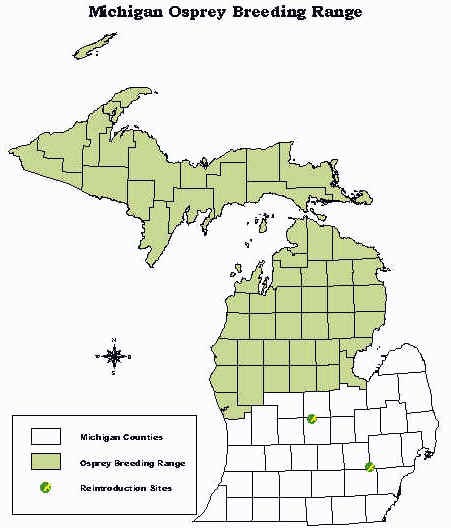OSPREY (Pandion haliaetus)
Osprey are 22-25 inches from beak to tail
and weigh between 2.5 and 4.0 pounds as adults. Their plumage is dark brown on the upper
part of their body and the underside is white. Females can be distinguished from males by
a dark band of feathers encircling their neck, resembling a necklace. An osprey’s
diet consists almost exclusively of fish. It catches its prey by plunging feet first into
the water to grasp fish just below the surface. Osprey nests are constructed over or near
the water. They are large and built of sticks.
Northern Hemisphere ospreys migrate south in the fall and
return north to nest during the summer.

Source: Unknown
Most Michigan osprey travel to South America for their winter homes. Male ospreys tend to
return to their birthplace after 2 years of age accompanied by a female to nest. Ospreys
will pair for life and use the same nest site in successive years.
Osprey populations rapidly declined during the 1960’s and
1970’s due to the widespread use of agricultural pesticides, specifically DDT. The
pesticides seeped into the waterways and ascended up the food chain into the flesh of the
fish that the osprey feed on. The DDT caused thinning in eggshells and many osprey eggs
cracked before the chicks hatched.

Source: Unknown
Fortunately osprey numbers are back on the rise. DDT was banned in the US in 1972 and the Michigan Department of Natural Resources (MDNR) has initiated many reintroduction efforts throughout southern Michigan. Male osprey chicks are taken from nests in northern MI at 5.5- 7 weeks of age. These chicks are transported to nest boxes in the desired reintroduction areas.
MDNR staff care for the chicks until they are ready for release. Males are more likely than females to return as adults to the fledging location for nesting. By raising male chicks in the reintroduction sites, it is anticipated that they will rebuild the southern Michigan osprey population.
This material has been compiled for educational use only, and may not be reproduced without permission. One copy may be printed for personal use. Please contact Randall Schaetzl (soils@msu.edu) for more information or permissions.